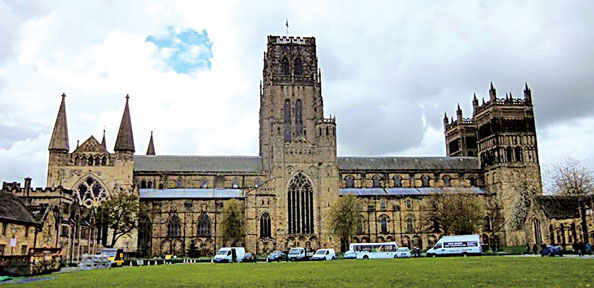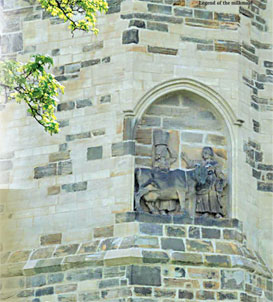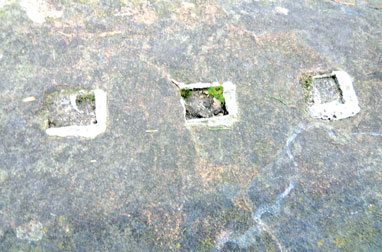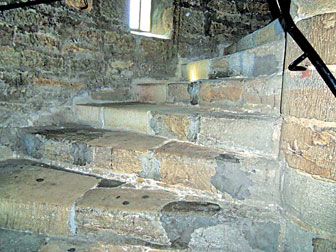|
Location for Rowling's Hogwarts:
Durham Cathedral- the Norman shrine of St. Cuthbert
By Chandana DISSANAYAKE in Durham
Dating back to 1093, the Shrine of St. Cuthbert in the town of Durham
in County Durham is venerated by Christians the world over this spring.
 A living monument of tribute towards Norman Romanesque architecture
in England, the Durham Cathedral, as it is popularly known, is steeped
in legend and history and is simultaneously of scholarly and
ecclesiastical merit. A living monument of tribute towards Norman Romanesque architecture
in England, the Durham Cathedral, as it is popularly known, is steeped
in legend and history and is simultaneously of scholarly and
ecclesiastical merit.
A research-related stay at the Durham University took me inevitably
to its illustrious neighbour and hours were spent there as the Chaplain
and guides to the Cathedral unravelled its history for the benefit of
the visitors.
It has been established that the original shrine was built by the
Prince Bishop William of St. Carilef (Calais) appointed by William the
Conqueror, following the Norman Conquest of 1066. The original
foundation for the Cathedral laid by Bishop William and the Normans is
still visible, along with its lead markings (see picture). The relics of
St. Cuthbert were enshrined in the Cathedral in 1104, having been
removed from the White Church in the same precincts where they had been
laid to rest earlier.
The body of St. Cuthbert had been made secure by the Monks of the
Lindisfarne Monastery (or the Community of St. Cuthbert) since his death
in 687 in several locations amidst numerous Danish invasions. Legend has
it that after many wanderings, the monks had finally arrived in the
peninsula in the loop formed by the River Wear in Durham.
There they had met a milkmaid searching for her lost dun
(light-brown) cow, and followed her to the site of the present shrine.
When the bier of St. Cuthbert's coffin was placed on the ground here it
had become immovable, indicating that the Saint wished his body be
interred at the location in a new structure.
The route taken by the Monks who followed the milkmaid is seen to
this day as the Dun Cow Lane, perhaps the oldest of its kind in Durham.
A work of sculpture on the outer wall of the Cathedral depicts this
legend (see picture).
 If the devout reach the Durham Cathedral in veneration of St.
Cuthbert, scholars and students identify with it in terms of the life
and work of the eighth century scholar St. Bede, whose body too rests
within the same precincts. If the devout reach the Durham Cathedral in veneration of St.
Cuthbert, scholars and students identify with it in terms of the life
and work of the eighth century scholar St. Bede, whose body too rests
within the same precincts.
St. Bede is well known for his work on the life of St. Cuthbert and
his 'The Ecclesiastical History of the English People' (Historia
ecclesiastica gentis Anglorum). St. Bede's contribution to English life
is seen in the form of translations from Greek and Latin that made more
reading on the doctrine available to the common people.
The Cathedral also finds a place in the military history of England,
as the temporal powers of the Prince Bishops of Durham involved defence
of the land and its people. During times of war or civil strife, the 217
ft. Cathedral Tower with its 325 steps served as a watch-tower and the
entire premises were used for military purposes.
It was also a sanctuary for fugitives. The main entrance to the
Cathedral had at one time displayed a knocker (a replica is still seen,
with the original found among the Cathedral's museum collection), to be
used by fugitives who sought refuge. They were given a few days to sort
out their affairs or to surrender to the law enforcement authorities.
Visitors also see Prior Castell's clock, dating back to the 16th
century and still in chime, a magnificent pipe organ and rare
manuscripts deposited in the Library of the Cathedral where research on
ecclesiastical history and Medieval England is often in progress.
Founder
The Durham University, the third oldest in England, had been founded
by Van Mildert the Bishop of Durham and the Cathedral Chapter in 1832. A
few years later, Bishop Mildert's Castle next to the Cathedral had been
vested in the university following his demise; it now houses Durham
undergraduates.
Audiences in Sri Lanka and the world over have seen segments of the
magnificent structure of the Durham Cathedral during the past few years
on the big and small screens - Harry Potter, Hermione Granger and Ron
Weasley find their Hogwarts within its cloister in several film versions
of the series; the game of quidditch is often seen practised in the
Cathedral's quadrangle!
 |
 |
 |
| Foundation with lead
works |
COL grave |
Steps to Cathedral
Tower |
|

